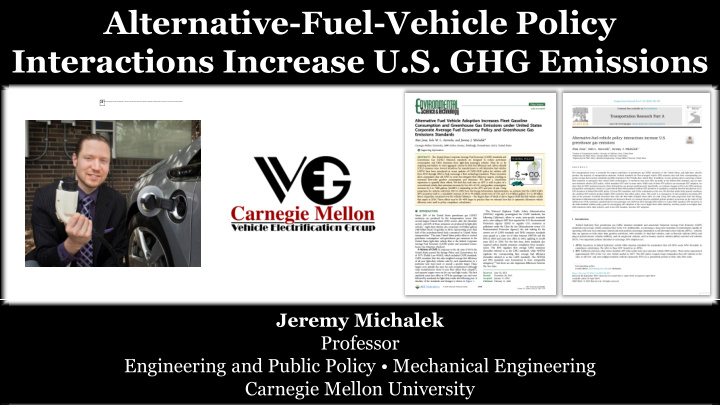



Alternative-Fuel-Vehicle Policy Interactions Increase U.S. GHG Emissions The linked image cannot be displayed. The file may have been moved, renamed, or deleted. Verify that the link points to the correct file and location. Jeremy Michalek Professor Engineering and Public Policy • Mechanical Engineering Carnegie Mellon University
Fleet Standards Constrain Fleet Emissions Alternative fuel vehicle (AFV) policies act under the umbrella of fleet standards In the U.S. NHTSA caps light duty fleet-averaged fuel consumption rates EPA caps light duty fleet-averaged GHG emission rates TE3 Conference | 18 Oct 2019 2 Jeremy J. Michalek
Policies to Encourage Transition to AFVs 1. AFV incentives in the federal fleet standards Weighting factors: Treat emissions from non-tailpipe locations as zero Multipliers: Treat 1 AFV sale as though >1 AFVs were sold Permit higher fleet emissions when AFVs are sold 2. State zero-emission vehicle (ZEV) mandate Require automakers to sell vehicles with zero tailpipe emissions TE3 Conference | 18 Oct 2019 3 Jeremy J. Michalek
Q: What are the effects of these AFV policies in the context of federal fleet standards ?
Comparing Policy Scenarios Relative to a pure national fleet standard, we assess what happens when we add AFV-Incentives in the federal fleet standard State ZEV mandates Both policies Two approaches Simulate using several EIA and CARB sales projections Identify mathematical conditions under which policies increase or reduce emissions TE3 Conference | 18 Oct 2019 5 Jeremy J. Michalek
Policy Interactions Increase Emissions State ZEV policy and AFV-Incentives in fleet standards both encourage AFV adoption But together they do so in a way that increases permitted fleet emissions Given AFV-Incentives in federal standards, any other effort to increase AFV sales triggers higher permitted fleet emissions TE3 Conference | 18 Oct 2019 6 Jeremy J. Michalek
Implications
Where Are We Now? Trump administration proposed Is this a bad deal? to freeze fleet standards at That depends what other 2020 levels through 2026 and options were feasible in the revoke CA’s waiver negotiation process CARB, Ford, Honda, BMW, VW But there are implications to agreed to maintain higher consider: standards (July 2019) Agreement includes expansion of AFV-Incentives in the fleet standards - California Air Resources Board TE3 Conference | 18 Oct 2019 8 Jeremy J. Michalek
Worthwhile Despite These Implications? EPA and CARB believe that near- It’s not yet clear whether long term emissions increases are term benefits specifically enabled acceptable in the pursuit of a by AFV-Incentives in federal fleet needed long term transition standards outweigh near term costs specifically caused by AFV- “ Incentives Near-term emissions increases are known ” – Federal Register Long-term effect on transition dynamics are uncertain But there are many ways to (we’re working on this now) encourage such a transition Some are more effective / costly than others TE3 Conference | 18 Oct 2019 9 Jeremy J. Michalek
Recommendation Phase out AFV incentives in federal fleet standards (If we can do so without substantially increasing fleet emissions targets in the political/negotiation process) Focus on other mechanisms to encourage an AFV transition Calibrate magnitude of policy push based on magnitude of externalities negative (e.g.: emissions) positive (e.g.: inappropriable benefits of EV R&D) TE3 Conference | 18 Oct 2019 10 Jeremy J. Michalek
Thank you
Recommend
More recommend